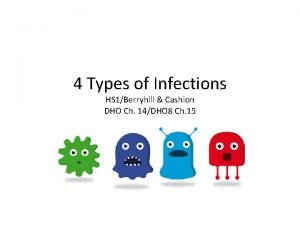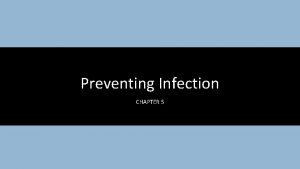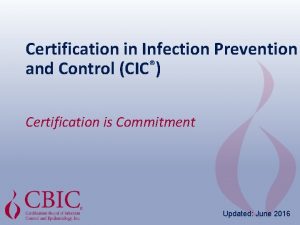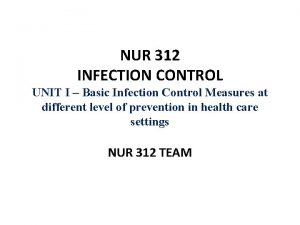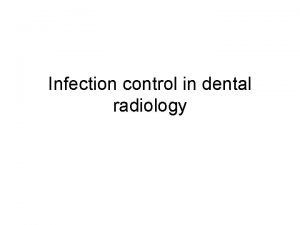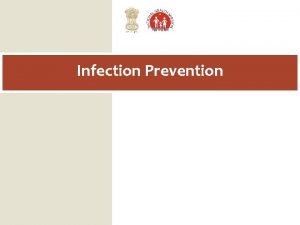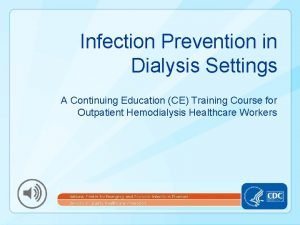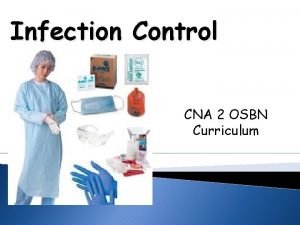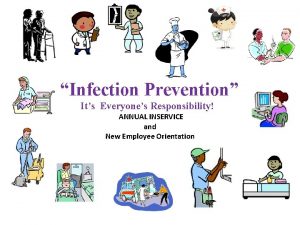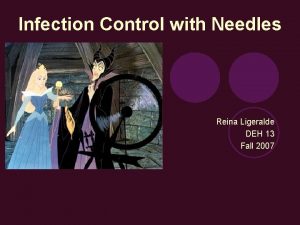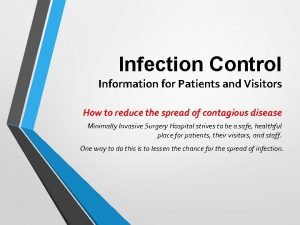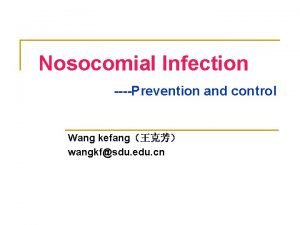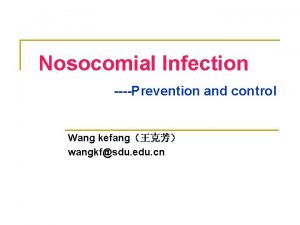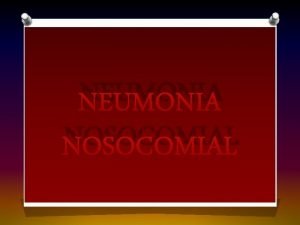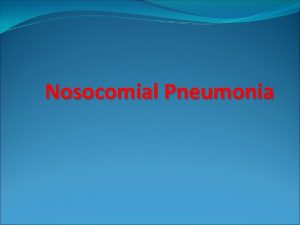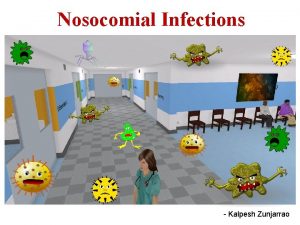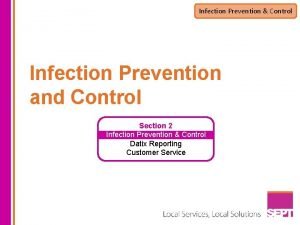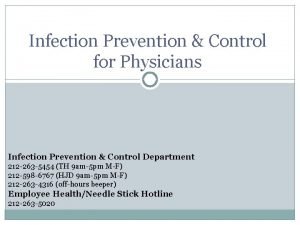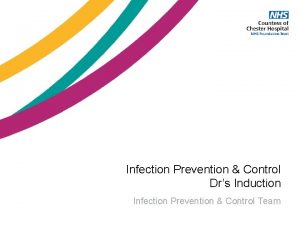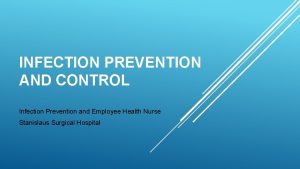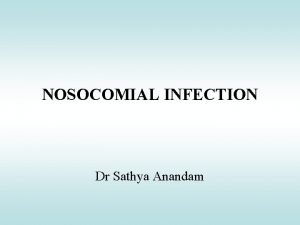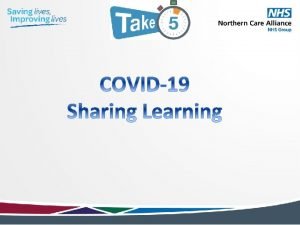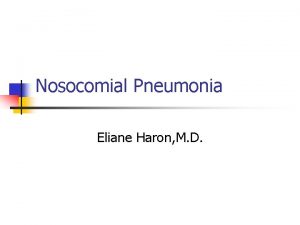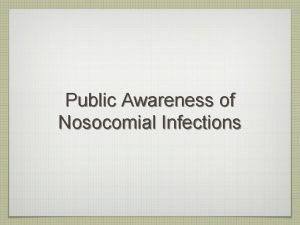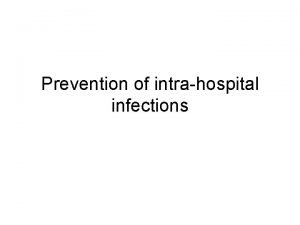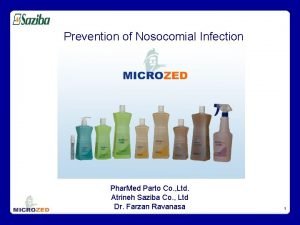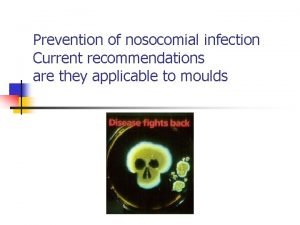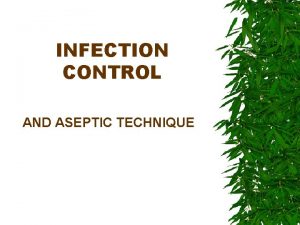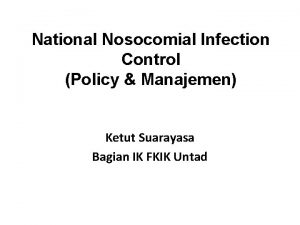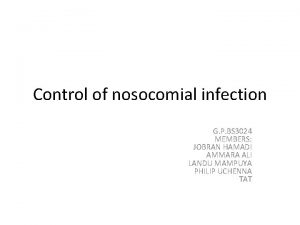Nosocomial Infection Prevention and control Wang kefang wangkfsdu























- Slides: 23

Nosocomial Infection ----Prevention and control Wang kefang(王克芳) wangkf@sdu. edu. cn

ScenarioⅠ Mrs. Helen is a 63 -year-old woman with diabetes who underwent a total hip replacement. She did well after surgery. On the afternoon of her seventh postoperative day, she complains to her nurse Kathy that she is having increased pain in her hip. Mrs. Helen also has a low-grade fever with a temperature of 37. 7℃. Kathy observes the incision and notes that it is red, swollen, and warm. Kathy and a registered dietitian did a nutritional assessment on Mrs. Helen and found that she had a poor nutritional intake 1 month before her surgery because of hip pain and an inability to stand to prepare meals. Questions: 1. What kind of signs and symptoms indicated that there’re something wrong with Helen? 2. How do you explain Mrs. Helen’s pain in her hip and fever?

Nosocomial Infection ----Hospital Acquired Infection n Broad concept q n Any infection or disease that any individual suffers from the invasion of pathogens in hospital. Narrow concept q q Any infection that patient suffers during their hospital care which was not present or incubating at the time of admission. This includes infections acquired in hospital but appearing after discharge, and also occupational infections among heath-care workers. ----� 生部《医院感染管理� 法》2006 Concepts

Classification n Endogenous infection (autogenous infection) q n The causative microorganisms come from the clients’ themselves. Exogenous infection (cross infection) q The causative microorganisms come from the other source than the clients’ themselves, such as:hospital personnel, other clients, and hospital environment.

Scenario Ⅱ n Mrs. Helen was diagnosed as surgical site infection. It is hospital acquired infection (HAI). Her doctor orders a wound culture for Etiological diagnosis and treatment. In addition, Mrs. Helen is receiving wound care, antibiotic therapy, and supportive care, including nutrition and progressive exercise. n Questions: 1. Try to find the risk factors from the patient herself. 2. Where does the causative microorganisms come from? 3. How does the patient get the causative microorganisms?

Chain of Infection Source of Infection Susceptible Host Chain of Infection Mode of Transmission

Sources of Infection n Human q q q may have active infections Carrier n may be in the asymptomatic and/or incubation period of an infectious disease, Endogenous patients’ normal flora n Animal and Insect n Health care setting q patients, healthcare personnel, family members and other visitors Environment, equipment and apparatus Chain of Infection

Modes of Transmission n Contact Transmission n Droplet Transmission n Airborne Transmission Chain of infection

Modes of Transmission n Contact Transmission q q Direct contact Transmission n transferred from one infected person to another person directly. Indirect contact Transmission n the transfer of an infectious agent through a contaminated intermediate object or person. n the contaminated hands of healthcare personnel are important contributors to indirect contact transmission Chain of infection

Modes of Transmission n Contact Transmission n Droplet Transmission n Respiratory droplets: q Coughs, sneezes, talks, secretion suction, endotracheal intubation, and cardiopulmonary resuscitation q Short distance <1 m n 猩红热、白喉、麻疹、流行性脑脊髓膜炎 Chain of infection

Modes of Transmission n Contact Transmission n Droplet Transmission n Airborne Transmission q q Fine particles/dust particles contain infective pathogens over time and distance Mycobacterium tuberculosis Chain of infection

Susceptible hosts n Factors affecting susceptibility include q q q age, gender, race and heredity normal immune defenses Physical health: n n q underlying disease and medical therapy nutritional status Mental health n n Stress depression Chain of Infection

Susceptible hosts n n n n younger children and older adults; severely impaired immune defenses; malnutrition; receiving various immune suppressed treatment; long-term use of antibiotics; receiving numerous invasive procedures; long operation time; extended length of hospitalization; Chain of Infection

Chain of Infection Source of Infection Susceptible Host Chain of Infection Mode of Transmission

Impact of nosocomial infection


SARS n During the SARS pandemic, the proportion of infected health-care workers ranged from approximately 20% to 60% of cases worldwide.

Impact of nosocomial infection q More serious illness or deaths q Prolong of stay in a health-care facility q Long-term disability q High additional financial burden:patients ,their families and society Infection control is very important for a hospital!!!


Risks for Nosocomial Infection n Immune defense decline q q q n Numerous invasive procedures q n Invasive devices are more important than underlying diseases in determining susceptibility to nosocomial infection Antibiotics abuse q n Physiologic factors Pathologic factors Psychological factors can cause resistant microorganisms to colonize in clients Ineffective management q Health care workers who use poor aseptic or hand washing techniques


WHO: Measures Technique: Aseptic Isolation Cleaning Disinfection Sterilization Infection control Correct use of antibiotics Surveillance of disinfection and sterilization efficacy

1 Basic Knowledge n Concepts n Classification n Risk factors n Chain of infection n Measures for infection control
 Beth has a nosocomial infection. how did she get it?
Beth has a nosocomial infection. how did she get it? Primary prevention secondary prevention tertiary prevention
Primary prevention secondary prevention tertiary prevention Chapter 16 infection prevention and control
Chapter 16 infection prevention and control Opsonization
Opsonization Puncture resistant container
Puncture resistant container Chapter 19 disease transmission and infection prevention
Chapter 19 disease transmission and infection prevention Chapter 19 disease transmission and infection prevention
Chapter 19 disease transmission and infection prevention Define infection prevention chapter 5
Define infection prevention chapter 5 Chapter 16 infection control and standard precautions
Chapter 16 infection control and standard precautions Standard precautions milady
Standard precautions milady Cbic recertification
Cbic recertification Dental radiographic interpretation ppt
Dental radiographic interpretation ppt Chapter 15:3 washing hands
Chapter 15:3 washing hands Chapter 15:7 cleaning with an ultrasonic unit
Chapter 15:7 cleaning with an ultrasonic unit Cic certification exam
Cic certification exam Infection control meaning
Infection control meaning Darkroom infection control guidelines
Darkroom infection control guidelines Learning objectives for infection control
Learning objectives for infection control Conclusion of infection
Conclusion of infection Neutropenic precautions
Neutropenic precautions Infection control is everyone's responsibility
Infection control is everyone's responsibility Infection control
Infection control Nsw health
Nsw health Infection control information
Infection control information
